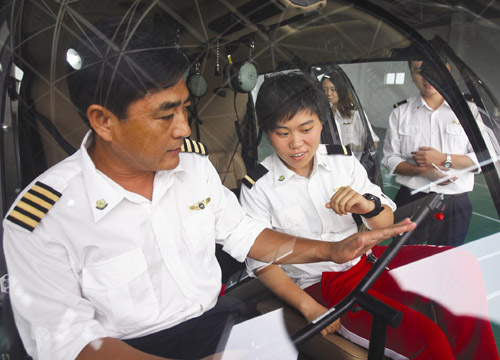






|
 |
|
An instructor gives a student a lesson about flying a helicopter. [Photo/China Daily] |
Also perhaps making people more willing to break the rules are the relatively meager penalties that are imposed on those who fly without licenses.
According to China's Civil Aviation Law, violators of the certificate requirements face fines of between 10,000 and 100,000 yuan.
Unlike Zhu, many wealthy people in China generally have little interest in purchasing their own aircraft and pilot's licenses.
Lu said there are only about 600 registered general aviation aircraft in China. He said the general aviation industry remains stunted despite the country's rapid economic growth.
Gao Yuanyang, director of the research center for the general aviation industry under the Beijing University of Aeronautics and Astronautics, said China needs at least three to five years to prepare itself for the industry's rapid development.
"The industry is connected very closely with policies and technologies," Gao said. "What China lacks now is not capital but airspace, talent and infrastructure resources."
A large part of Chinese airspace is closed to civil traffic.
Lu cited three obstacles to the industry's development.
"People in China are not used to traveling by general aviation," Lu said. "That's just not part of the culture here. Besides that, there is very little supportive infrastructure, including general aviation airports and maintenance centers, in the country."
He said requirements stipulate that aircraft be checked both before taking off and after landing. The country now lacks the operations it needs to fuel, inspect and repair aircraft.
"The US has more than 500 airports for civil aviation and 5,000 for general aviation, but China only has 200 for civil purposes and fewer than 100 for general use."
"The airspace management authorities should also move faster to open up low-altitude space, which is extremely important to the development of China's general aviation industry," Lu said.
He said too many departments in both the government and the army are trying to guide the reforms.
In 2010, the country announced plans to have low-altitude airspace opened to the industry by 2015. And an administrative regulation concerning general aviation was put forward in 2003.
"But the regulation, which is under revision now, is no longer applicable," Lu said. "The country's national aviation law is still under consideration. Cooperation and compromise must take place if they want to make any progress."
Lu said his company may look at making general aviation aircraft. His company's business now concerns first aid, air tourism and aviation leasing.
He said the number of civil helicopters in China will increase by 25 percent a year in the next five years. By 2020, there will be 2,100 of the vehicles in the country.
"China's general aviation industry now has about 4 billion yuan in profits a year, which is less than 1 percent of the US industry's. China's general aviation industry needs to improve in many ways. If investors want to enter this industry, they should be patient and give up their expectation that they will be making profits in several years."
"The industry has some big opportunities as well as some big obstacles," said Lu. "If the impediments can be removed, a bright future awaits all of these ambitious companies."
Contact the writers at cangwei@chinadaily.com.cn and songwenwei@chinadaily.com.cn